Benchmarking GeForce GTX Titan 6 GB: Fast, Quiet, Consistent
We've already covered the features of Nvidia's GeForce GTX Titan, the $1,000 GK110-powered beast set to exist alongside GeForce GTX 690. Now it's time to benchmark the board in one-, two-, and three-way SLI. Is it better than four GK104s working together?
Results: World Of Warcraft: Mists Of Pandaria
Resolution: 1920x1080
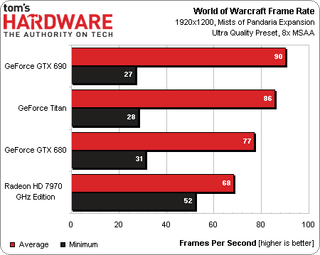
A chart that looks like this demands a frame rate over time graph to help explain the results. Strangely, the Radeon HD 7970 GHz Edition posts the lowest average performance number, but gives us the highest minimum frame rate. Because the red bar is already plenty-high, we’d actually call AMD’s outcome the best.

Our benchmark runs between two flight points in Pandaria. On all three Nvidia cards, frame rates drop under 40, even at 1920x1080, when we jump on our taxi. The AMD board doesn’t experience this severe spike, which is why, even though its average is lower across the flight, its minimum frame rate is still higher.
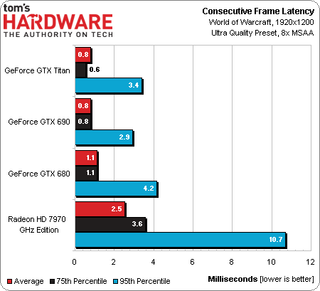
None of the consecutive frame latency numbers are problematic, and, at least to my eyes, playing through the game at this resolution is comparably smooth on all four solutions.
Resolution: 2560x1600
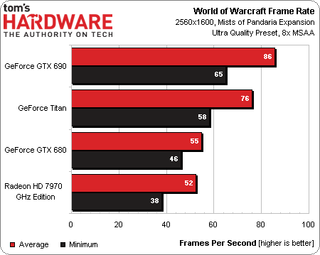
The minimum frame rate discrepancy between AMD and Nvidia is gone at 2560x1600. We instead see results that correspond to the averages, which suggest all four of these cards remain playable. In World of Warcraft, however, GeForce GTX Titan comes closer to the first-place GeForce GTX 690 than the 680 below it.
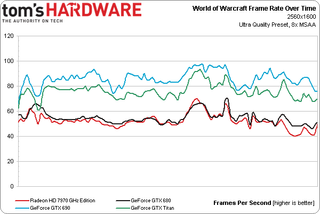
Indeed, that dip at the start has disappeared on Nvidia’s GeForce boards. Rather, the GeForce GTX 680 and Radeon HD 7970 GHz Edition trade blows, while Titan spends most of its time in excess of 70 FPS. Although our flight path-based test isn’t the end-all in World of Warcraft benchmarking (even if we did spend hours trying to come up with the most taxing flight sequence in the new expansion), we suspect this card would have little trouble in a crowded raid at 2560x1600.
Stay on the Cutting Edge
Join the experts who read Tom's Hardware for the inside track on enthusiast PC tech news — and have for over 25 years. We'll send breaking news and in-depth reviews of CPUs, GPUs, AI, maker hardware and more straight to your inbox.
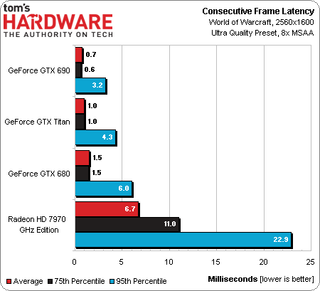
A low average consecutive frame latency, a slightly higher 75th percentile, and a spike at 95 suggest that most of the frames AMD’s Radeon HD 7970 GHz Edition renders have relatively little lag between them, but that the worst samples from the test worsen considerably. Based on real-world gameplay, we’re not convinced that the Radeon card’s result is palpable, even if its lag is several times higher than what Nvidia’s cards convey.
Resolution: 5760x1200
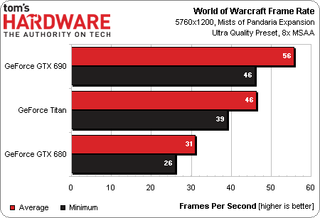
More problematic for AMD is that a Radeon HD 7970 GHz Edition doesn’t appear to support 5760x1200. It instead forces three screens to run in mirrored mode.
It’s probable that the Radeon wouldn’t have given us playable frame rates anyway, based on GeForce GTX 680’s performance. GeForce GTX 690 and Titan do, however, yield numbers we’d be comfortable gaming at using 5760x1200 at Ultra quality settings.

There’s little to add based on frame rates over time. Both $1,000 cards appear quick enough, while the GeForce GTX 680’s flirtations with sub-20 FPS bode less well for taxing boss fights.
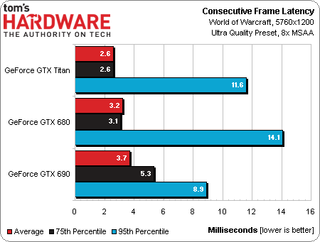
Latencies jump on all three cards, though the averages remain very low.
Current page: Results: World Of Warcraft: Mists Of Pandaria
Prev Page Results: The Elder Scrolls V: Skyrim Next Page Results: Two- And Three-Way SLI Performance-
Novuake Pure marketing. At that price Nvidia is just pulling a huge stunt... Still an insane card.Reply -
whyso if you use an actual 7970 GE card that is sold on newegg, etc instead of the reference 7970 GE card that AMD gave (that you can't find anywhere) thermals and acoustics are different.Reply -
cknobman Seems like Titan is a flop (at least at $1000 price point).Reply
This card would only be compelling if offered in the ~$700 range.
As for compute? LOL looks like this card being a compute monster goes right out the window. Titan does not really even compete that well with a 7970 costing less than half. -
downhill911 If titan costs no more than 800USD, then really nice card to have since it does not, i call it a fail card, or hype card. Even my GTX 690 make more since and now you can have them for a really good price on ebay.Reply -
spookyman well I am glad I bought the 690GTX.Reply
Titan is nice but not impressive enough to go buy. -
hero1 jimbaladinFor $1000 that card sheath better be made out of platinum.Reply
Tell me about it! I think Nvidia shot itself on the foot with the pricing schim. I want AMD to come out with better drivers than current ones to put the 7970 at least 20% ahead of 680 and take all the sales from the greedy green. Sure it performs way better but that price is insane. I think 700-800 is the sweet spot but again it is rare, powerful beast and very consistent which is hard to find atm. -
raxman "We did bring these issues up with Nvidia, and were told that they all stem from its driver. Fortunately, that means we should see fixes soon." I suspect their fix will be "Use CUDA".Reply
Nvidia has really dropped the ball on OpenCL. They don't support OpenCL 1.2, they make it difficult to find all their OpenCL examples. Their link for OpenCL is not easy to find. However their OpenCL 1.1 driver is quite good for Fermi and for the 680 and 690 despite what people say. But if the Titan has troubles it looks like they will be giving up on the driver now as well or purposely crippling it (I can't imagine they did not think to test some OpenCL benchmarks which every review site uses). Nvidia does not care about OpenCL Nvidia users like myself anymore. I wish there more people influential like Linus Torvalds that told Nvidia where to go.
Most Popular


